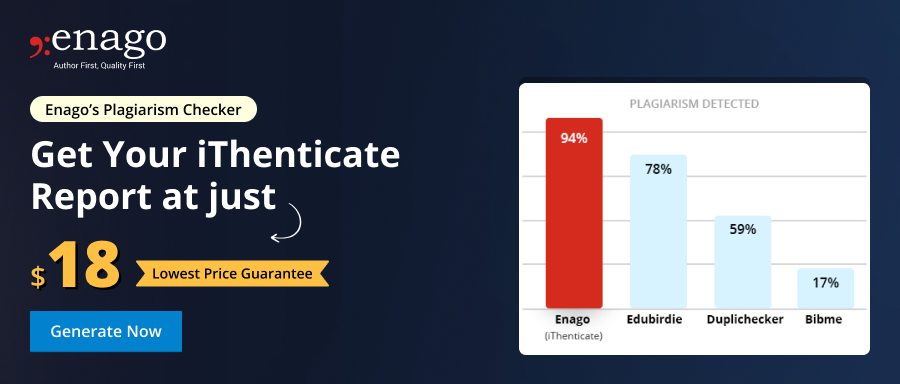How to Publish With Confidence: A comprehensive iThenticate guide

This guest post is drafted by an expert from iThenticate. iThenticate helps researchers surface potential plagiarism by uploading and comparing submissions against more than 170 million scholarly articles, a database of 70+ billion current and archived web pages. This ensures that they will pass the initial screening and manuscript review process, thereby providing confidence during the high-stakes publication process. With iThenticate, you can compare your content against 95% of the top 10,000 most-cited journals, including exclusive coverage of Crossref member journals. Find out how iThenticate will help you publish with confidence.
For academic researchers, the adage of “publish or perish” is still true. A significant part of their reputation and ability to proceed forward in their career hinges on the ability to publish. Very often, the publication process is a very intricate, high-stakes, and risky enterprise. The smallest mistake can cost someone a career, a reputation not only of an individual researcher, but also the entire institution they represent, or restriction to funding.
What’s more, competition in the publishing domain is expected to grow rapidly over the course of the next ten years due to the increase in funding and many new researchers joining the field. Even in times of the pandemic, government research support remains steady and continues to grow. By 2030, it is estimated that the number of researchers will expand from 20 million to 30 million worldwide. However, the publishing opportunity is not increasing likewise, with only 1.2 million more articles estimated to be published in 2030. Consequently, the aspects of selection and reputation will be more vital than ever before when it comes to submitting research.
Because of this, academic researchers will need to use all means available to them from the very beginning of the research process. This is to ensure that their work contributes uniquely to the field and is free from misconduct or plagiarism.
Thousands of the most respected researchers from around the world trust iThenticate to verify the originality of their work. Why?
- Top publishers as a part of their standard screening and review process use only iThenticate.
- Researchers have access to the same tool and content as top publishers such as Elsevier, Taylor & Francis, Nature, Springer, ProQuest Dissertations and Theses, and Wiley-Blackwell.
- iThenticate compares against the biggest content database of 70 billion current and archived web pages, 165 million journal articles from the world’s premier academic publishers, and the option for a private repository for your institution’s documents.
Where to Start: Stages of the Research Originality Verification
Checking for originality is something that should happen at every stage of the research process. Right from writing the manuscript all the way through screening by the publisher, to editing, and publication.
Stage 1: Pre-Research
At this initial stage, it’s important to understand whether your topic selection is unique and likely to garner funds and acceptance for publication. Use iThenticate’s Similarity Report to scan your draft or grant proposal and see the coverage of topics and publications likely to generate interest in your research.
Matches and sources will point to other authors and journals that are covering the topic. This helps in identify potential collaborators. Also, if you don’t have alternate journals in mind, the Similarity Report can point you to lesser-known journals that are potentially a good fit for submission.
iThenticate is also a great resource to prepare grant proposals to secure funding for your research. Reviewing your proposal can reveal similarities and help you feel confident that your research is unique and qualifies for the best funding opportunities.
Based on an internet and database search, iThenticate generates a similarity score. It reflects the measure of how much a manuscript is similar to previously published text.
iThenticate is a great tool for researchers and postgraduate students. I’ve been advising my students to use it regularly and been giving lectures about research ethics. While doing so, iThenticate is my only example!
– Z. Al-Hourani, Jordan University of Science & Technology, Jordan
Stage 2: Writing
After researching, comes the challenging work of preparing your results and writing your manuscript. Usually, this work is a collaborative effort involving multiple contributors and dozens of drafts. At this stage, iThenticate similarity report helps co-authors collaborate confidently. Additionally, it ensures that the manuscript does not have inadvertent plagiarism errors.
Double-check each draft as you collaborate on the manuscript and share reports with the colleagues. This helps to fix the smallest inaccuracies before submission.
I have tried several plagiarism detection tools, iThenticate is by far the best and most accurate tool in the market. I highly advise graduate students, professors, and researchers to use it.
– Dr. Samer Barakat, Applied Science University, Jordan
Stage 3: Publishing
One of the major advantages as a researcher is knowing that iThenticate is a central component of the publishers’ workflow. Knowing that publishers are using the same tool to review your work gives researchers greater confidence in passing the initial originality screening. Furthermore, it can seriously boost the chances of your research being accepted for publication. Once accepted, using iThenticate to re-submit drafts similar to how you work with editors and peer reviewers, makes it easier to prevent mistakes or potential plagiarism.
Key Takeaway
As a researcher, ensuring publishing and increasing your academic reputation is one of the most important aspects of your career. Moreover, the entire process of research and publication is arduous and complex! Therefore, it’s a relief to have a tool like iThenticate that can provide you confidence in the originality and integrity of your submission. Resolving simple errors of attribution, co-author collaboration, and document management becomes simple. In at least some aspects, the high-stakes world of academic publishing is simplified, giving researchers the peace of mind they need to publish with confidence. To learn more about iThenticate, visit iThenticate.com.










